HOW TO BECOME A MINIMALIST: 7 WAYS TO START TODAY
A minimalist lifestyle is about clearing the clutter from your home, heart and mind to create space for the things which really matter most to you. In this article I’m sharing some tips on how to become a minimalist and 7 ways to start today if you’d like to try it for yourself!
WHAT DOES IT MEAN TO BECOME A MINIMALIST?
Minimalism is a lifestyle choice that encourages you to think differently about what you have in your life. From decisions about what clutters your home to defining your priorities and what’s important to you, minimalism is a popular way of simplifying our increasingly complicated lives.
More and more of us are pulling away from busy schedules and overstretched brains and seeking a happier, fulfilled and easier life with less stuff, more breathing space and greater emphasis on the important things in life.
“Minimalism is a tool we use to live a meaningful life. There are no rules. Rather, minimalism is simply about stripping away the unnecessary things in your life so you can focus on what’s important.”
Joshua Fields Millburn
In this article I’m sharing some ideas on how to become a minimalist and 7 easy ways to start today if you’re new to the idea but curious to try it for yourself.
They’re a mixture of practical tips to help you clear the clutter, explain more about the minimalist lifestyle but also some ideas on how to shift your mindset and begin to think like a minimalist.
After all, minimalism for real life is as much about the way you think about your life as it is about the actual stuff in your life.
THE BENEFITS OF THE MINIMALIST LIFESTYLE
Minimalism has changed my life for the better in so many ways. Many people come to my blog wanting to learn how to declutter their homes, but then they love the feel and look of less stuff so they apply the same minimalist principles (of keeping what matters and removing what doesn’t) to other aspects of their home and life.
You can read about some of these steps below as I explain how you too can be a minimalist.
Some of the benefits of minimalism that I and others have felt include:
- A home that’s easier to run, keep clean and tidy and is more peaceful and welcoming to its occupants
- More time and freedom in your schedule for doing what you WANT, not just what you need
- Saving money or spending more wisely by not buying stuff you don’t need and investing in experiences and memories instead
- A life that supports you through challenges such as older age, menopause, mental health, loss and grief, anxiety, ADHD and those HSPs and introverts who crave a sanctuary to retreat to from the outside world
- Better self-care and healthcare habits such healthy eating, improved sleep and more regular exercise
- A focus on intentional and purposeful living, personal growth and living a meaningful life.
GETTING STARTED WITH MINIMALISM
Before I move on to give you some suggestions on how you can get started with minimalism, there are a few points that I’d like to highlight first as I think they may help.
1. Minimalism can often be misinterpreted
There are many misunderstandings and myths around what the minimalist lifestyle is about. For example, it’s a common misconception that becoming minimalist means you’ll have to throw all your stuff away.
Whilst it’s true that a minimalist lifestyle is about removing the clutter in your life and focusing on what’s important, what that means in practice is different for all of us.
You can read about my own personal thoughts on minimalism and how I’ve embraced minimalism in my own life at the end of this article.
“Minimalism isn’t about owning less than you need. It’s about owning exactly what you need.”
Joshua Becker
My minimalist life with kids, work, school and the stuff that comes with that might be different to someone with a different set of commitments and responsibilities but I’m no less of a minimalist.
I have a full life just with less stuff than many people and keep a mindful watch on when the clutter tries to creep back in!
2. Stop over-thinking
Considering the pros and cons of a minimalist lifestyle and doing lots of background research is great, but it can also stop you from getting started.
Decluttering is a popular first step and it’s where you can define what’s important to you by deciding what to keep and what to get rid.
Finding a place to get started and continuing with consistent, baby steps, to clear the clutter is what you’re aiming for.
Give yourself time to really feel the benefits of decluttering, it may take time just like clutter takes time to build up.
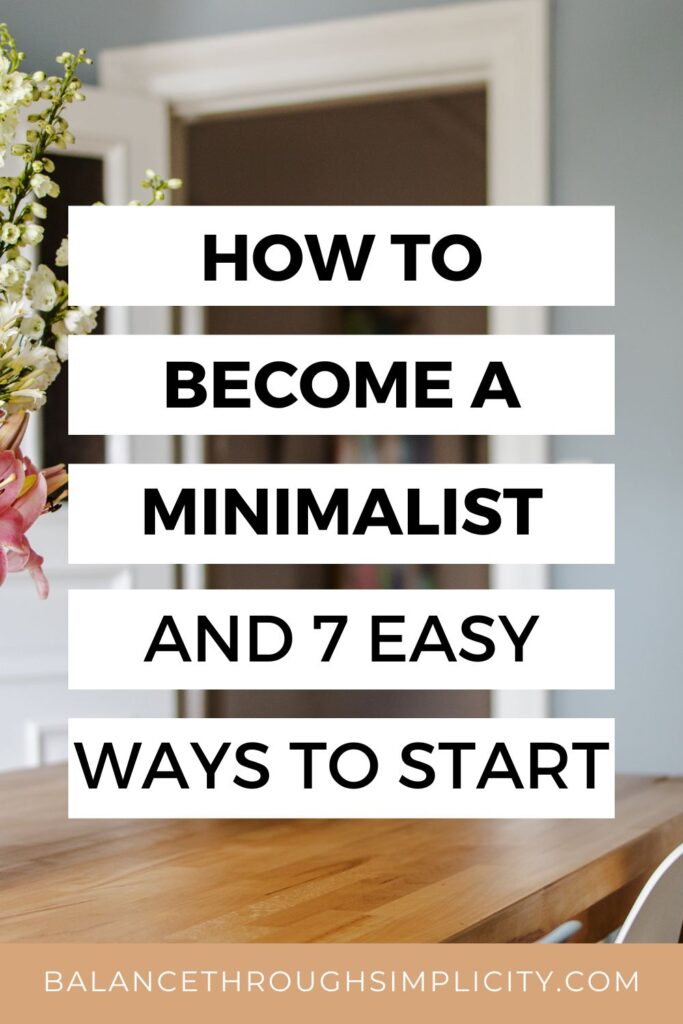
3. Learning to let go
When we’ve spent money, time and effort bringing stuff into our lives, it seems counter-intuitive to want to clear them away.
Learning to let go, get rid of, move on, say no, can take courage and practice. We’re often conditioned to say yes to every invite or opportunity because it seems churlish or selfish to say no.
Instead, find ways to decline or postpone, get comfortable with donating or recycling instead of throwing away and again, take baby steps.
7 WAYS TO START BECOMING A MINIMALIST
Try these practical ideas to explore what minimalism could mean for you in everyday life. Try them out for size and see how they make you feel.
1. A minimalist wardrobe
A minimalist wardrobe tends to have fewer clothes. Instead of a closet stuffed full of pieces that you don’t really wear, perhaps think about ways you could benefit from having fewer clothes.
You’d have more space in your wardrobe, less stuff to rummage through each morning when you’re getting dressed in a hurry and fewer decisions to make because you have fewer (but better) options.
A minimalist wardrobe doesn’t have to include a set number of pieces, you don’t even need to follow a capsule wardrobe. However, I do believe a wardrobe filled with less clothes can give you more freedom and flexibility.
The key is choosing clothes that you love to wear, feel good and confident in wearing, that are versatile to mix and match with each other, are easy to care for and that really suit your lifestyle.
A cluttered closet tends to be overstuffed with things we don’t wear very often, don’t feel very good wearing, we can’t find anything to match with and that just take up space. They make getting dressed a hassle rather than something we look forward to doing each morning.
Simplify your wardrobe by:
- Decluttering items that you don’t wear
- Choosing pieces that you can reach for knowing they’ll fit perfectly and you’ll feel good wearing
- Organising what you have left and,
- Donating, recycling or throwing away the rest.
Suggested reading:
- How to Declutter Your Clothes
- 12 Capsule Wardrobe Tips: A Simple Wardrobe Made Easy
- Simplify Your Wardrobe Toolkit – a workbook to help clear your closet and love your clothes
- If you like the idea of a limited number of pieces in your wardrobe, try Courtney Carver’s Project 333.
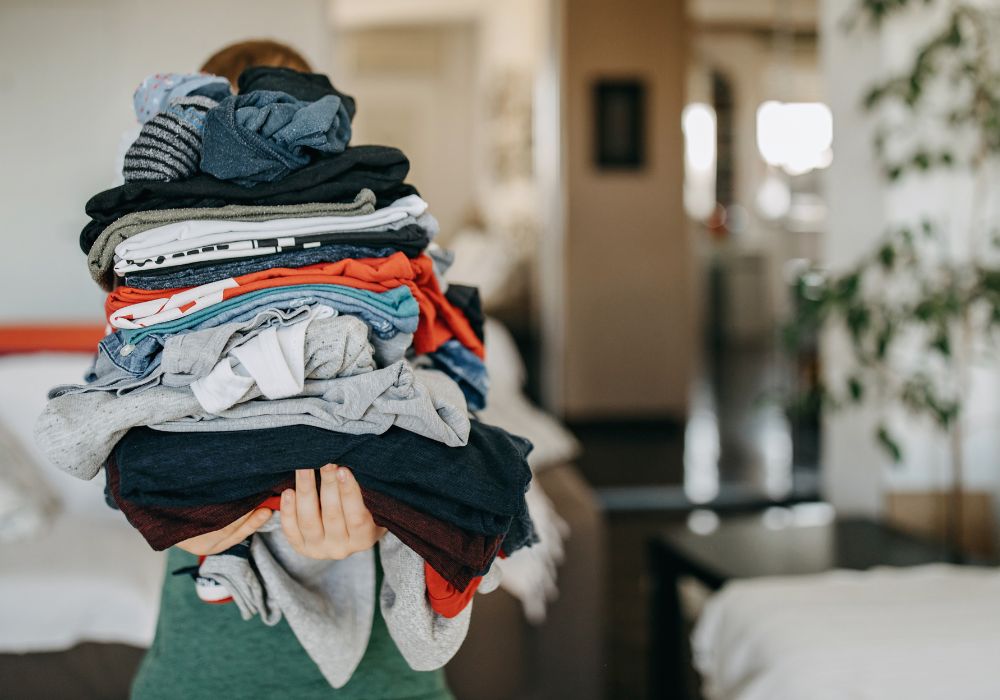
2. Minimalist meal-planning and eating
We all have to eat and most of us have to cook or prepare food in order to eat! Remove the stress and reduce the time it takes you to prepare your food by choosing simple, healthy meals.
Complicated recipes that require lots of ingredients or that have many different preparation stages are ok if you love cooking and have plenty of time to devote to it.
However, if you’re feeding your family day in, day out or have limited time, energy or motivation to spend hours in the kitchen, choosing simple, minimalist meals with a focus on quick and healthy, are a good choice to help you enjoy making dinner.
Take a look at my article on simple tips for healthy eating to get started or this article on meal planning made simple for quick, stress-free tips on minimalist meal planning.
3. A minimalist home
It probably goes without saying that minimalist homes are clutter-free (for the most part anyway). It doesn’t mean they don’t have stuff in them but the stuff they do have is carefully chosen and deliberately there.
There’s no random clutter stuffed in cupboards hidden out of sight, there aren’t garages or attics full-to-brimming with items kept for those ‘just in case’ and ‘what if I need them’ moments. Sound familiar?!
By getting rid of the random, unwanted and unnecessary clutter there are two big benefits. You’re creating:
- More physical space in your home so it appears bigger, you have more room to move around in, better utilise the space you do have and it’s calmer and less visually distracting to distract and confuse your brain!
- More time for what’s important to you because you don’t have to spend time tidying, moving or cleaning the stuff. What else would you be rather doing instead?!
If you’d like more help on decluttering your home then here are some helpful resources:
- 20 Ways to Declutter Your Home – projects to get started on right now
- 14 Tiny Decluttering Projects – decluttering when you don’t have time or aren’t sure where to start
- 5 Life-Changing Benefits of Decluttering Your Home and Life – why decluttering impacts our life in so many ways
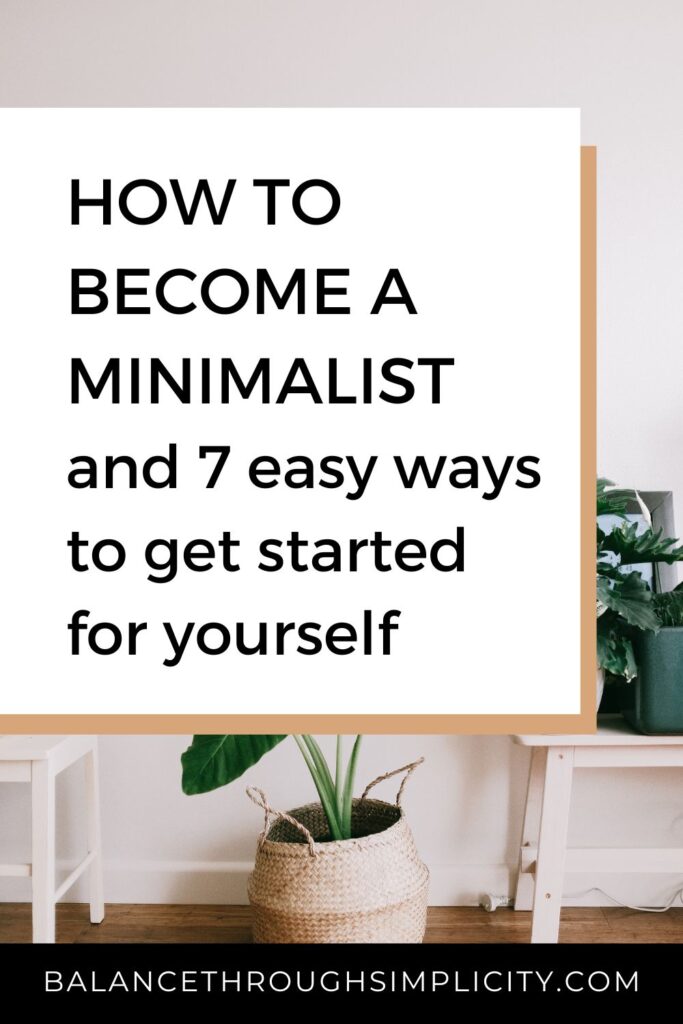
4. Minimalist shopping habits
Minimalist living doesn’t mean you can’t go out shopping or spend money. Of course, minimalism and frugal living can go hand in hand if you want them to, but I also know that plenty of minimalists like to buy new things and spend money!
What I do encourage you to do if you’re trying to become a minimalist, is to shop more mindfully. Before you hit the shops because you’re bored or feeling down, and definitely before you get tempted by big red ‘sale’ signs and huge discounts, think carefully whether you really need that item.
Ask yourself some questions:
- Is it going to add value to my life or contribute in some meaningful way?
- Will it replace something I already have?
- Is it an upgraded, better or newer version which means you could donate, recycle or throw the other one you already have?
Instead of adding to your clutter by buying stuff just for the sake of it, ask yourself why you’re shopping and do you really need that item.
Would you be better off saving that money, paying off debt, or spending your money on non-physical items that could bring long-lasting memories rather than just more short-term clutter?
If you’re a shopaholic, or just like to hit the shops at the weekend but want to explore a more minimalist lifestyle, check out this post on Minimalism and Shopping: 18 ways to shop with intention. I’ve included some helpful tips to encourage you to think differently about your shopping habits.
5. A minimalist schedule
Getting rid of clutter is the start of your minimalist journey. However, clutter isn’t just physical stuff that you can see. It’s also stuff that you can’t.
Our diaries and our time can be cluttered in the same way as our shelves or cupboards. Too many appointments and things to do leaves us too little free space in our schedule. In fact, if you look back on your day, week or month, how much space and free time did you have?
When we fill our time with stuff that we don’t want to do or don’t need to do, we’re cluttering up our calendar in the same way we clutter up our homes with stuff.
Think about decluttering your schedule, choosing carefully what you say ‘yes’ to, learning perhaps to say ‘no’ a little more. Give yourself more free time to do the things you WANT to do, rather than just what you NEED to do.
Suggested reading:

6. Practice gratitude
I believe that gratitude is a vital component of a minimalist life. Everywhere we turn, we’re bombarded by messages to buy more, achieve more, strive for bigger and better.
Yet, all this chasing means we end up with overstuffed homes and lives. Being grateful for what we have, building on that instead of chasing the next big thing, helps us create the best life we can right now.
When we stop believing we need more stuff to make us happier, richer, more successful, more fulfilled, we begin to appreciate what we have already.
Suggested reading: How to Use Gratitude to Improve Your Life
7. Define your priorities in life
I love decluttering so it was a natural progression for me to become minimalist. I’m generally tidy and organised and I find it really therapeutic ditching my clutter and creating a clean, open living space where my kids can play and my husband and I can relax. Yet, many people find decluttering overwhelming and difficult.
The important thing to remember is that decluttering is only PART of the process to becoming a minimalist. It’s just a tool at your disposal to help you get rid of your stuff. Decluttering is not the end goal.
The true value in becoming a minimalist lies in what happens afterwards. What does decluttering your home and your life REALLY give you? It’s not just less stuff to clear and tidy.
For me, it’s more time, space and freedom to do the things that I and my family WANT to do, by making it quicker and easier to do the things I NEED to do. Life isn’t perfect but it’s happier, freer and far less stressful.
I invite you to think about what you really want out of life:
- What are your priorities?
- What REALLY matters to you?
- If you can gift yourself more free time, more energy and more space, what would you do instead?
Define your priorities and what’s important to you, get clear on what’s just cluttering your home and life and embrace a life that’s fuller, just with less stuff!
Suggested reading: How Less Can Be More
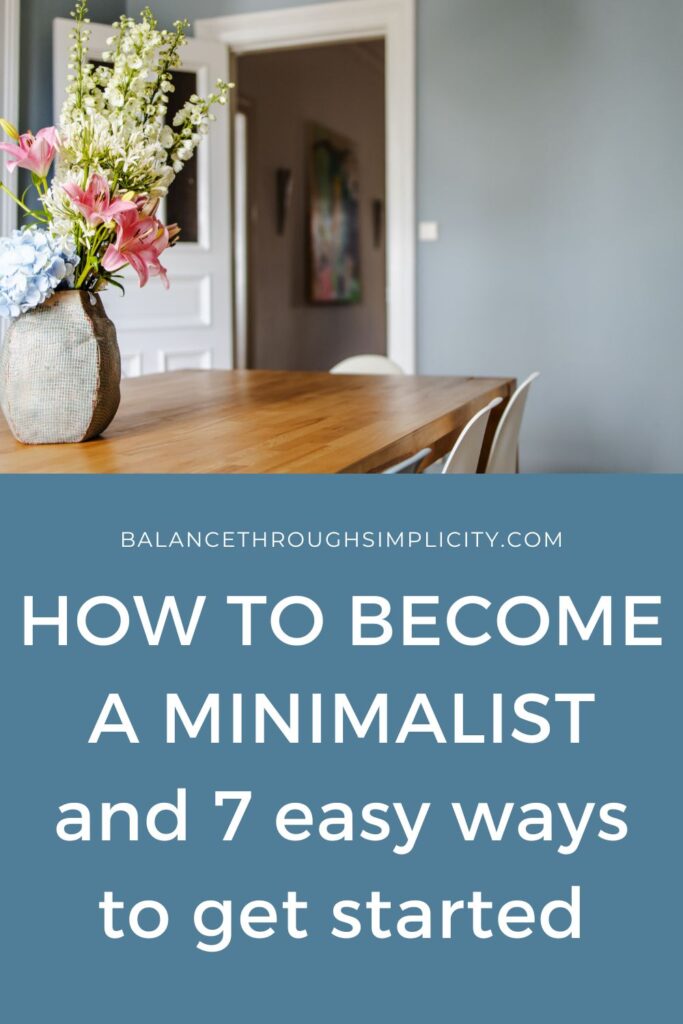
IF MINIMALISM STILL FEELS SCARY OR UNREALISTIC
I hope you found this article helpful and you’re inspired to try some of the ideas I’ve offered on how to become a minimalist.
But, I know that minimalism can still feel scary, unrealistic or too extreme. The picture that’s often painted of minimalist homes can make them and the lifestyle feel cold, unwelcoming and impractical if you have a full, busy and varied life.
After all, modern culture, social media and advertising tells us from every angle that to be happy, fulfilled and successful in life, we surely need to say yes to everything, buy as much as we can and fill our homes and lives with the best and most that money can buy.
Whilst stuff and money can certainly bring their own benefits, they’re not the only ways to live true to yourself and what matters to you. Sometimes we need to clear the clutter, live intentionally and prioritise what’s important. To do this doesn’t always require yet… more… stuff…
I thought it might be helpful to share some personal thoughts around what minimalism means to me.
I teach a gentle, compassionate form of minimalism that focuses on not just your stuff but also on your priorities. And importantly, how you can embrace minimalism in your own life, in whatever way that looks like to YOU.
Here are some articles you might enjoy to explore how to become minimalist in your own home and life.
- Why Minimalism Is Not Just About Your Stuff – Minimalism involves decluttering and getting rid of things you no longer need, want or add value to your life but the minimalist lifestyle is also so much more. Here are some reasons why minimalism is not just about your stuff.
- Thoughts on Minimalism for Real Life – Minimalism sometimes feels unattainable or unrealistic but I don’t think it has to be this way. Take a warm-hearted, gentle approach to living an intentional life, full of purpose and less full of stuff. Here are some personal thoughts on minimalism for real life.
- 9 Lessons I’ve Learned From Minimalism – Minimalism gets some pretty bad press but I do think it’s provided me with some important lessons over the years which have helped me build a better life for myself and my family. I’m very grateful for all it’s taught me in so many ways! Here are 9 lessons I’ve learned from minimalism over the years.
RESOURCES FOR MINIMALIST LIVING
If you’d like more information and help on how to become a minimalist yourself, here are some resources which you might find helpful:
- 20 Reasons to Own Less Stuff – the benefits of less stuff and more life.
- Minimalist Lifestyle Tips – 18 tips to help you embrace minimalist living every day
- Declutter Starter Kit – a free guide and workbook to help you understand the what, why and how of decluttering. Projects, tips and guidance to clear the clutter in your home and life.
DON’T MISS OUT!
I’m Antonia and on this blog I share practical inspiration to simplify your home, time and life. Follow me on Instagram, Facebook and Pinterest! You can also subscribe to Balance Through Simplicity and receive regular simplicity tips straight to your inbox for free. Make sure you never miss an article plus you’ll get a copy of my free Declutter Starter Kit as a welcome gift!

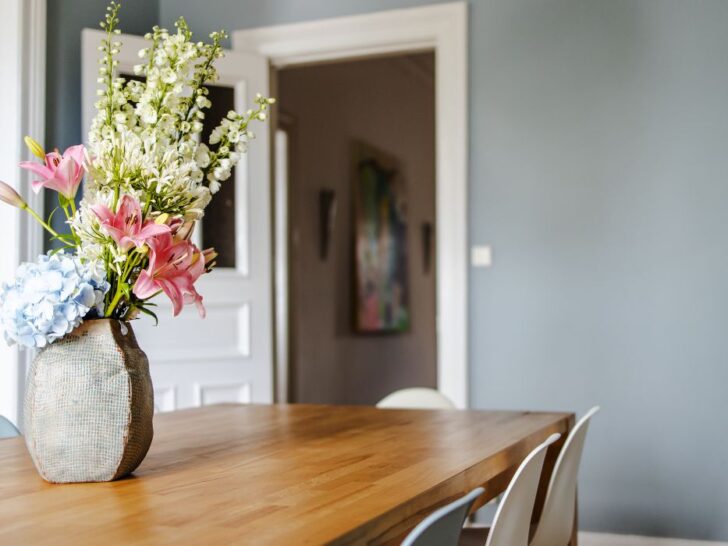
Chuck Johnston
Wednesday 17th of August 2022
Thank you for this column, Antonia. Minimalizing is difficult, but your approach makes it a progression and not a cold turkey approach. Making steady progress towards an end goal is a good way to look at it. A marathon, not a sprint? I appreciate your work.
Balance Through Simplicity
Thursday 18th of August 2022
Thank you so much for your lovely comment. I totally agree. Steady progress is much more likely to stick and be change that's right for you. Too fast, too soon and it's more of quick impulse than an intentional and purposeful shift in lifestyle and mindset.